Color is extremely important to birds so they have evolved different ways to “paint” themselves.
Black-colored feathers come from a molecule called melanin – that’s the same substance that gives color to our skin and hair.
Melanin makes the surface stronger and more resistant to abrasion; according to research published by the Oxford University Press, having black feathers can also help birds become up to 9% more aerodynamic.
Melanin isn’t the only pigment that leaves its mark on the color of the birds – another group of pigments called carotenoids create the orange color.
Birds can not produce it naturally and instead obtain it from eating different plants that contain those pigments – carotenoids circulate through the bloodstream and to their cells.
And according to research published in the Journal of Evolutionary Biology, beak color might function mostly as a social, not a sexual signal, as it was long presumed.
Many birds face intense competition during breeding and non-breeding periods; colorful bills became an evolutionary adaptation to showcase dominance and fighting ability to others so the contests are settled quickly, without resorting to physical combat.
So what are some of these dominant black birds with orange beaks?
Examples of black birds with orange beaks include the toco toucan, common blackbird, Inca tern, crested auklet, black oystercatcher, surf scoter, and many others.
Here are 20 of them and their photos.
Table of Contents
Black Birds With Orange Beaks
Toco Toucan
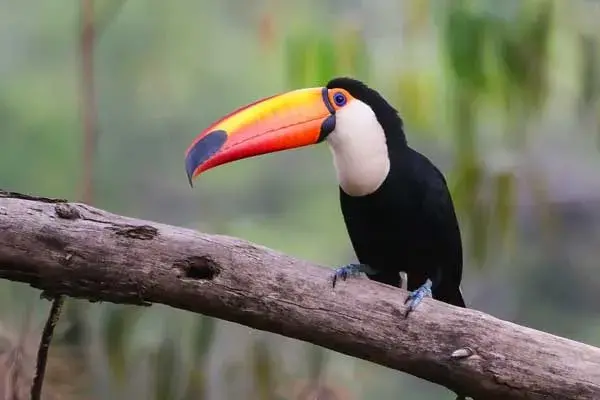
- Scientific name: Ramphastos toco
- Lifespan: 20 years
- Wingspan: 40-60 in
- Beak Color: Bright orange
Toco toucans, also known as giant toucans, are the largest and most famous members of the toucan family.
They are black with white throats and orange skin around their eyes.
Toco toucans’ most prominent feature is the beak which is over 7 inches long and has a bright orange color.
Compared to their body size, they have one of the largest beaks in the world that take 30-50% of their total body surface area.
Although it seems massively heavy, the beak is very light because it is hollow and made of keratin (a protein our hair, skin, and nails are made of).
When they sleep, toucans tuck their beaks under their feathers to keep them warm. On the other hand, when the weather gets very hot, 30 to 60% of heat is lost through the beak.
Toco toucans are not very good fliers and mainly travel among trees by hopping.
These black birds with long orange beaks inhabit the semi-open habitats of central and eastern South America, in countries like Bolivia, Peru, Argentina, Paraguay, and Brazil.
Toco toucans are omnivores that use their massive orange beaks to pluck fruit from trees and grab some insects, frogs, small birds, their eggs, and even small reptiles.
Want to see what they look like without beaks? Check out this interesting article.
Common Blackbird
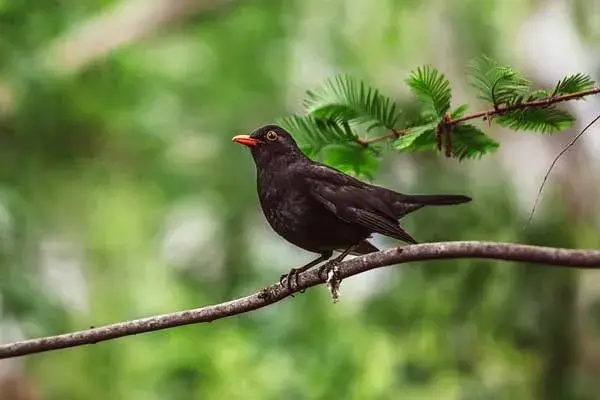
- Scientific name: Turdus merula
- Lifespan: 4 years
- Wingspan: 15 in
- Beak Color: Orange (males), brown (females)
Common blackbirds are small birds found in wooded habitats, parks, gardens, and farmlands with hedges in Europe, Asia, and North Africa.
In North America, people refer to them as Eurasian blackbirds so they are not confused with similarly-looking but unrelated New World blackbirds.
Male common blackbirds are glossy black with bright golden-orange beaks.
Females are brown and have dull yellowish-brownish beaks.
These small black birds with orange beaks become very territorial during the breeding season and males will often use “bow and run” displays to chase away competitors. They will run headfirst at the opponent, raise their heads, and then bow with their tails dipped simultaneously.
Territorial males will be more aggressive towards males with brighter orange beaks; females, on the other hand, are not interested in beak color and respond more to shinier beaks.
Males have a rich melodious song they sing around urban and suburban neighborhoods with trees and hedges.
Source: Oona Räisänen (Mysid), Public domain, via Wikimedia Commons
Common blackbirds are omnivores that feed on worms, fruits, and seeds.
Scientists estimate that there are between 160 to 500 million of these animals in existence today.
Indian Blackbird

- Scientific name: Turdus simillimus
- Lifespan: 2-3 years
- Wingspan: n/a
- Beak Color: Bright orange
Indian blackbirds are small black birds with orange beaks once considered subspecies of common blackbirds.
They are native to Asia, in India and Sri Lanka, and can be found around forests, forest edges, and orchards.
Depending on the subspecies, Indian blackbirds are mostly dark black-brown with bright orange beaks and patches of skin around the eyes.
They can be also identified by their beautiful fluting songs, often emitted around the foothills of forests.
Source: L. Shyamal, CC BY-SA 3.0, via Wikimedia Commons
When the winter comes, Indian blackbirds might move to lower altitudes, relatively close to people.
Crested Auklet
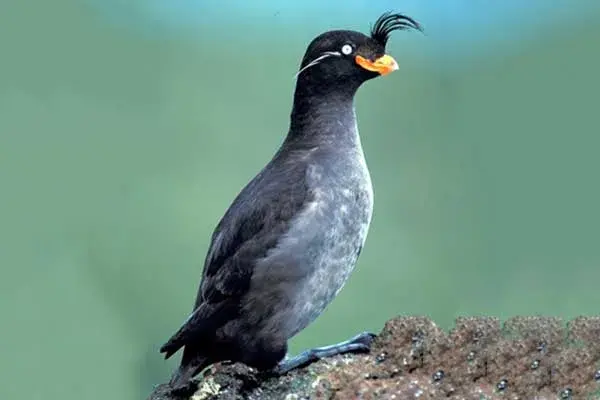
- Scientific name: Aethia cristatella
- Lifespan: 8-10 years
- Wingspan: 13-20 in
- Beak Color: Bright orange
Crested auklets are dark black-brown stocky seabirds with a crest of feathers on top of their heads.
People describe them as “smiling clowns that never blink and smell like a tangerine”.
Crested auklets have thick, short, and orange beaks with yellow tips.
Scientists in 2017 discovered that these small birds have ornamental bill plates – temporary structures that surround their beaks during mating season – that are fluorescent.
Although unsure of the purpose of such brightness, they speculate that it might have something to do with their mating rituals where, in one part, they fully insert their half-open beaks into their potential partner’s plumage.
Crested auklets are found in Alaska, Japan, and Russia, around island coasts with lots of rocks and boulders; during the non-breeding season, they live on the open ocean.
They are very social birds that nest in colonies that can include over 1 million individuals!
Crested auklets are planktivores (carnivores) and feed on krill, copepods, pteropods, etc.
They forage in deep waters, together with other auklets, and dive to grab their food.
Read More: More examples of black-colored water birds
Inca Tern

- Scientific name: Larosterna inca
- Lifespan: 2-3 years
- Wingspan: 12 in
- Beak Color: Bright orange-red
Inca terns are large terns that can measure around 16 inches in length.
These seabirds are black-gray and have white mustaches on their faces, white edges on their wings, and bright orange beaks and legs.
The mustache is the health sign of the tern – the longer it is, the healthier the bird.
They were named so because they are common in the habitat ruled by the ancient Inca Empire in South America.
They breed on the coasts of Chile and Peru, on rocky cliffs, and can be identified by their catlike “mew” calls.
Inca terns are piscivores that feed on fish, plankton, shrimp, crayfish, crab, etc.
These black water birds with long beaks are also kleptoparasitic –they steal food from other animals like sea lions and dolphins.
Inca terns will often fly over the water, spot their prey under the surface, and dive into the water and grab it with their sharp, pointed beaks.
Common Hill Myna

- Scientific name: Gracula religiosa
- Lifespan: 15-20 years in captivity
- Wingspan: n/a
- Beak Color: Bright orange with yellow tip
Common hill mynas are glossy black mynas with bright yellow head wattles.
They are found in mature humid forests and forest edges of South and Southeastern Asia.
Common hill mynas have glossy jet-black plumage, bright orange beaks with yellow tips, and patches of bright orange-yellow skin and fleshy wattles on the side of their heads and napes.
They are very noisy and most vocal around dusk and dawn; identify common hill mynas by their loud high-pitched whistles, wails, screeches, and gurgles.
In the wild, they do not mimic other birds, but in captivity, they are one of the world’s finest.
Sadly, due to their striking black color, orange beaks, and excellent vocal abilities, they are often trapped and sold to private collectors, which results in the decline of their populations.
These social birds love to form small groups of around 6 birds and can be often seen hopping sideways along tree branches.
They are omnivores and feed on insects, fruit, and nectar.
Black-breasted Thrush
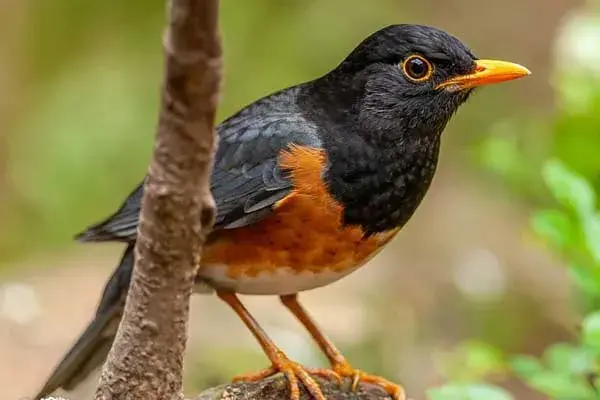
- Scientific name: Turdus dissimilis
- Lifespan: n/a
- Wingspan: n/a
- Beak Color: Yellowish-orange
Black-breasted thrushes are small passerines (perching birds) found from India to Vietnam.
They breed in mid-to-high-elevation forests, at altitudes ranging from 4,000 to 8,200 feet and descend into foothills and upper lowlands in the winter.
Both sexes of these forest thrushes are similar; males tend to be slightly darker and the species was named after the black color of the chests that the males have.
Male black-breasted thrushes are black on top while females are mostly gray-brown; both have orange-yellow bills, legs, and feet.
The call of the black-breasted thrush has been described as “sweet mellow” and “melodious”, with their musical phrases including 3–8 notes.
They are omnivores that feed on insects, mollusks, and berries.
Bateleur

- Scientific name: Terathopius ecaudatus
- Lifespan: 27-40 years
- Wingspan: 66-75 in
- Beak Color: Multicolored (red, orange, black)
Bateleur is a French word that means “tight-rope walker” and refers to the bird’s unstable way of flying.
These medium-sized eagles have long wings and very short tails.
Bateleurs are mostly black with silver-whitish wings, bright red faces and legs, and bills with black tips, yellow-orange centers, and red bases.
Bateleur can change the color of the skin around their beaks depending on the mood – when relaxed, the skin is pale red or orange; when excited, it changes to bright red.
These birds of prey are found throughout sub-Saharan Africa, around open woodlands and savannas.
Bateleurs will spend about 9 hours a day hunting; they prey on antelopes, mice, birds, snakes, carrion, and lizards, and are quite fond of road kills.
They have several rather peculiar behaviors.
These eagles will often dip in water and then spread their wings and turn to the sun to dry, to keep themselves groomed.
Scientists have also noted bateleurs laying on the ground and warming up the oil produced by their uropygial glands that keeps their feathers in good condition; they will use their powerful beaks to spread the oil around.
They will also let ants crawl onto their feathers to clear them of bits of food, dead skin, and old feathers, and then ruffle their feathers which make ants produce formic acid as part of their self-defense mechanism.
This keeps the eagles clear of ticks, fleas, and other parasites.
Atlantic Puffin

- Scientific name: Fratercula arctica
- Lifespan: 20-30 years
- Wingspan: 19-25 in
- Beak Color: Multicolored (orange, black, yellow)
Atlantic puffins, also known as common puffins, are small diving seabirds native to the Atlantic Ocean.
Identify Atlantic puffins by their black upperparts, white underparts, white faces and cheeks, orange webbed feet, and the puffins’ black, orange, and yellow beaks.
They have rather unique beaks; when viewed from the front, beaks tend to be quite narrow, but when viewed from the side, they are broad and triangular.
The tip is orange-red while the part closer to the head is grayish-black.
Similar to crested auklets, these puffins develop characteristical bright orange bill plates before the breeding season and shed them after breeding – when placed under UV light, Atlantic puffins’ beaks light up.
There are 3 species of Atlantic puffins and one of the differences is their beak size; puffins living at higher altitudes tend to have bigger beaks and higher weight.
Because of their parrot-like beaks, people have nicknamed them “sea parrots”.
Atlantic puffins are carnivores that feed on small fish like sand eels, herring, hake, and capelin.
These black birds with orange beaks and feet are short-distance migrants and excellent fliers – puffins can flap their wings up to 400 times per minute!
Tufted Puffin

- Scientific name: Fratercula cirrhata
- Lifespan: up to 6 years
- Wingspan: 14 in
- Beak Color: Bright orange-red
Tufted puffins, also known as crested puffins, are unique-looking seabirds found throughout the North Pacific Ocean.
They are the largest puffin species and measure around 14 inches long and weigh around 1.6 pounds.
Tufted puffins are all-black with white faces, long yellow tufts curling around their napes (during breeding season), and very thick orange-red beaks and feet.
They will use their powerful beaks to dig nesting burrows and carry lots of small fish in their beaks to their chicks to feed them.
Tufted puffins have specialized serrations in their beaks that help hold large quantities of fish – scientists recorded a puffing carrying 62 fish in its beak!
They also have short wings that are adapted for diving, swimming, and capturing prey underwater.
They are carnivores that feed on fish and invertebrates, especially squid and krill.
In North America, they breed during summer from Washington State to British Columbia (Canada). During that period, their beaks become intensely colored.
They breed in large colonies on rocky islands and cliffs; one such included over 50,000 birds!
When the winter comes, they can be seen on the open sea.
Wattled Curassow

- Scientific name: Crax globulosa
- Lifespan: 20 years
- Wingspan: 36 in
- Beak Color: Red-orange with black tip
Wattled curassows are large, mostly black, terrestrial birds with curled crest feathers and very long tails.
They were named after the bright orange-scarlet knobs and wattles on their bills with black tips, especially noticeable in females.
They are found in Colombia, Mexico, and Ecuador, around tropical lowlands, riverine and humid forests.
Curassows are a threatened species with around 5,000 individuals alive today.
These large black birds with orange beaks are omnivores that feed on leaves, fruits, seeds, and small animals such as fish, crustaceans like shrimp, insects, etc.
Males can be recognized by their low-pitched booming sounds and high, descending whistle “wheeee” calls.
Read More: More examples of long-tailed black birds
Black-and-gold Cotinga
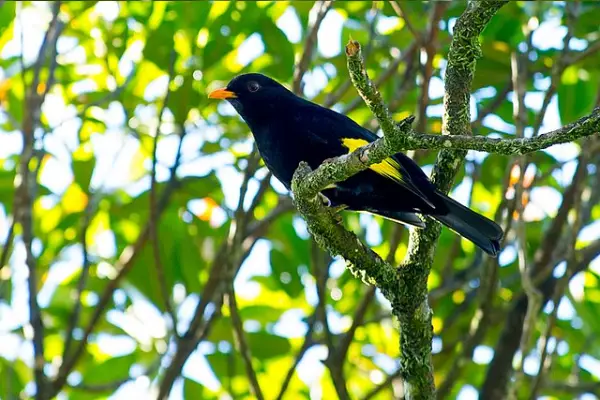
- Scientific name: Lipaugus ater
- Lifespan: n/a
- Wingspan: n/a
- Beak Color: Orange
Black-and-gold cotingas are birds endemic to south-eastern Brazil.
They are sexually dimorphic species, males and females look different.
Male black-and-gold cotingas are all-black with orange beaks and yellow patches on wings; females are olive-green but also have orange beaks and small red irises.
They can be identified by their song which is a long sharp and high-pitched whistle.
These birds inhabit highlands at elevations ranging from 3,900 to 6,700 ft.
Black-and-gold cotingas are omnivores and have a diet consisting of fruits and some insects.
Read More: List of black birds with yellow on their wings
Crowned Hornbill
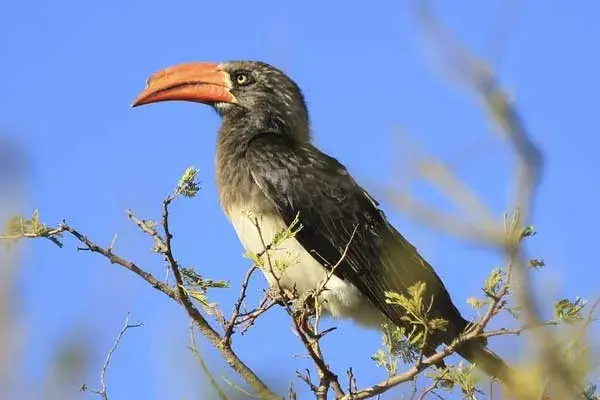
- Scientific name: Tockus alboterminatus
- Lifespan: 10-15 years
- Wingspan: 20 in
- Beak Color: Dark orange-red
Crowned hornbills are medium-sized birds and a species of hornbill.
They are native to Africa, in countries like Ethiopia, Angola, Zaire, Kenya, Uganda, Somalia, Zimbabwe, Mozambique, and South Africa.
They inhabit lush woodlands, forests, and forest edges.
Crowned hornbills are dark black-brown above, white below, and have long orange beaks, accentuated by casques (enlargement on the upper mandibles of their beaks).
They are common in small flocks and can be identified by a call consisting of a series of high, piping notes.
Crowned hornbills are omnivores and feed on fruits, small birds, lizards, and golden moles.
Golden-crested Myna

- Scientific name: Ampeliceps coronatus
- Lifespan: 15-20 years
- Wingspan: n/a
- Beak Color: Pale orange-yellow
Golden crested mynas are conspicuous glossy black birds with pale orange beaks and bright yellow heads and wings.
Males have a more extensive yellow on the head than females but both sexes have orange beaks.
Their main habitat is subtropical or tropical moist lowland forest, but golden crested mynas can be also found in heavily degraded former forests. They are common in north-eastern India and Indochina.
These birds mostly feed on insects and fruits, sometimes on small fish and lizards.
The word “myna” means “bubbling with joy”, coming from a Sanskrit “madana” meaning joyful or delightful, which is derived from the root meaning “bubbles.”
Read More: More examples of black birds with yellow heads
Black Skimmer
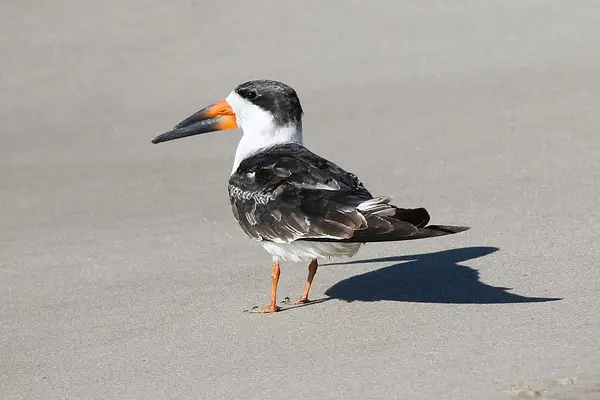
- Scientific name: Rynchops niger
- Lifespan: up to 20 years
- Wingspan: 42-50 in
- Beak Color: Black and orange-red
Black skimmers are large tern-like seabirds that are black above, white below, and have dark brown eyes, and red legs. During the non-breeding season, they become browner.
They are the largest of the three skimmer species and can measure up to 1 ft 8 inches in length.
Part of their scientific name “Rynchops” comes from the old Greek and means “cut-off bill” which perfectly describes these birds.
Black skimmers have unique beaks where the lower mandible is longer than the upper; the base of the beak is orange-red while the rest is mainly black.
Such beak adaptation allows them to skim along the water surface and catch fish.
These black water birds inhabit rivers, coasts, and lagoons and feed there on small fish, insects, crustaceans, and mollusks.
Black skimmers are permanent residents of southern parts of the United States, around Alabama, Florida, Louisiana, Mississippi, and Texas.
Identify them by their barking “kak-kak” calls.
They are social birds that nest in colonies with up to several hundred pairs; both parents will take turns and incubate their 3-5 eggs.
Black Oystercatcher

- Scientific name: Haematopus bachmani
- Lifespan: 10-14 years
- Wingspan: 28-36 in
- Beak Color: Bright orange-red
Black oystercatchers are large birds commonly found on the shorelines of western North America.
They inhabit rocky marine habitats that provide both nesting and foraging areas.
Black oystercatchers have all-black plumage, long orange-red beaks, pink legs, red eyes, and red rings around them.
The thick and long beaks have a strong orange-red glow to them and from distance looks like the species is eating a carrot!
Their razor-sharp beaks are useful for prying open oysters and other bivalves for food, hence the name “oystercatchers”.
These black birds with long beaks can be often seen during the day foraging, preening, resting, and sunbathing.
They have a global population of around 10,000 individuals; around 400 of those are estimated to live in the state of Washington.
Part of their scientific name, “bachmani,” is after John Bachman, the friend of naturalist John James Audubon that named the species.
Snail Kite
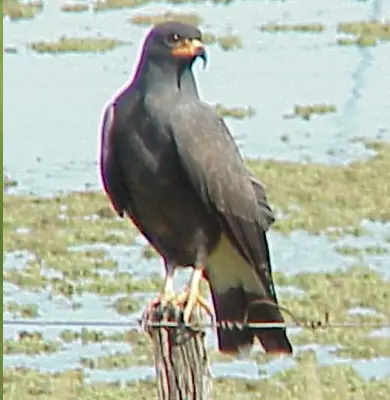
- Scientific name: Rostrhamus sociabilis
- Lifespan: up to 14 years
- Wingspan: 39–47 in
- Beak Color: Reddish-orange with a black tip
Snail kites are medium-sized raptors with broad wings, long legs, and broad tails.
They breed in South America, the Caribbean, and Florida in the USA, and can be seen around freshwater marshes year-round.
Male snail kites are charcoal black with hooked reddish-orange beaks with black tips.
Females are slightly larger and are mottled brown.
Snail kites were named after their favorite food, apple snails.
The beaks that measure around 1.3 inches are an adaptation to their diet – these raptors will hold a snail with one foot and extract the animal from its shell using their deeply hooked beaks.
They are usually solitary or in pairs during summer; when the winter comes, they will roost together in groups.
Snail kites will often make quick “ka-ka-ka” alarm calls or softer “kuk-kuk” contact calls.
One subspecies of snail kites found in the Florida Everglades is the Everglade snail kite (Rostrhamus sociabilis plumbeus).
These Florida-native birds are endangered and some estimates claim that just around 400 pairs live there.
Read More: More examples of birds that are native to Florida
Javan Myna
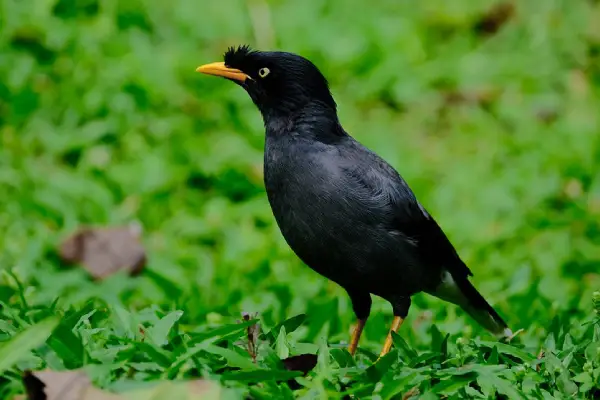
- Scientific name: Acridotheres javanicus
- Lifespan: 5-10 years in the wild
- Wingspan: 15.7 in
- Beak Color: Bright yellow-orange
Javan mynas are small crested black birds native to the Indonesian islands of Bali and Java.
They are also known as white-vented mynas and belong to the starling family, a group of small-sized passerine birds.
Javan mynas can be easily recognized by their small size, black plumage, yellow-orange beaks, brownish-black wings, and a short crest on their forehead.
These small black birds also have lemon-yellow eyes and yellow-orange legs and feet.
Javan mynas are omnivores and feed on seeds, fruit, nectar, insects, and human waste. They are very bold and not afraid of humans.
Javan mynas are quite social birds that feed in groups. While others feed, one Javan myna will sit at a vantage point and keep watch for danger or trouble.
Read More: More examples of black birds that have yellow bills
Gray-winged Blackbird
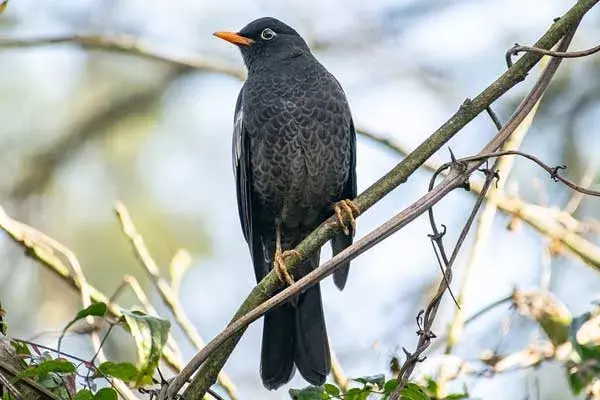
- Scientific name: Turdus boulboul
- Lifespan: n/a
- Wingspan: n/a
- Beak Color: Bright orange
Gray-winged blackbirds are large thrush species found in subtropical or tropical forests of south-eastern Asia.
As the name suggests, this species has flashy silvery-white wings; males are black and females are brown.
Gray-winged blackbirds have bright orange beaks.
They are often found solitary but when the winter comes, they might form some flocks.
Gray-winged blackbirds can be also recognized by their sweet song consisting of warbled phrases.
These black birds with orange beaks are omnivores that feed mostly on insects, their larvae, caterpillars, slugs, snails, earthworms, some fruits, and berries.
Read More: Examples of orange-billed birds of Florida
Surf Scoter
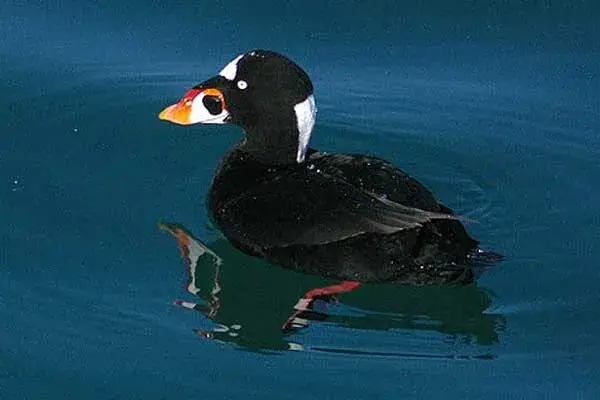
- Scientific name: Melanitta perspicillata
- Lifespan: 9-10 years
- Wingspan: 30-36 in
- Beak Color: Multicolored (orange, white, and black)
Surf scoters are large sea ducks native to North America.
They are “molt migrants” – after nesting, adults will go to a specific area to molt their flight feathers.
Surf scoters are jet black with orange, white, and black beaks and some white patches on the foreheads, napes, and bases of their beaks.
Females are slightly smaller and more brown.
They breed in Canada and Alaska and migrate to the Atlantic and Pacific coasts of North America for winter.
Surf scoters breed in boreal forests near freshwater lakes and winter in marine habitats near the shore.
These orange-billed ducks are mostly quiet but will make a couple of sounds: gurgling calls, explosive “puk-puk,” and “guk” alarm calls.
To catch the prey, they will dive and go up to 30 feet deep.
Surf scoters are carnivores and mostly feed on mollusks, crustaceans, aquatic insects, small fish, marine worms, etc.
If you are interested, feel free to read our list of differently colored birds that have orange beaks.
Summary
This concludes our list of black birds with orange beaks.
Examples include several types of starlings, blackbirds, puffins, toucans, auklets, etc.
Hopefully next time you see these birds, you will recognize any of them with ease!
And if you enjoyed our article, here’s another popular read on birds: List of incredible black birds with red wings and List of incredible ducks with blue bills